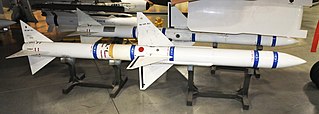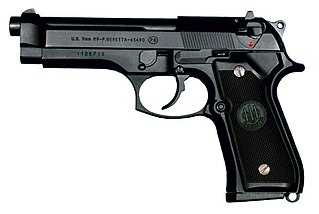 W
WAGM-45 Shrike is an American anti-radiation missile designed to home in on hostile anti-aircraft radar. The Shrike was developed by the Naval Weapons Center at China Lake in 1963 by mating a seeker head to the rocket body of an AIM-7 Sparrow. It was phased out by U.S. in 1992 and at an unknown time by the Israeli Air Force, and has been superseded by the AGM-88 HARM missile. The Israel Defense Forces developed a version of the Shrike that could be ground-launched with a booster rocket, and mounted it on an M4 Sherman chassis as the Kilshon.
 W
WThe AGM-65 Maverick is an air-to-ground missile (AGM) designed for close air support. It is the most widely produced precision-guided missile in the Western world, and is effective against a wide range of tactical targets, including armor, air defenses, ships, ground transportation and fuel storage facilities.
 W
WThe AGM-88 HARM is a tactical, air-to-surface anti-radiation missile designed to home in on electronic transmissions coming from surface-to-air radar systems. It was originally developed by Texas Instruments as a replacement for the AGM-45 Shrike and AGM-78 Standard ARM system. Production was later taken over by Raytheon Corporation when it purchased the defense production business of Texas Instruments.
 W
WThe AGM-122 Sidearm was an American air-to-surface anti-radiation missile produced between 1986 and 1990. While not as capable as newer anti-radiation missiles, they were cheaper and lighter in weight allowing more versatile deployment.
 W
WThe AGM-183 ARRW is a hypersonic weapon planned for use by the United States Air Force. Developed by Lockheed Martin, the boost glide weapon is propelled to a maximum speed of Mach 20 by a missile before gliding towards its target.
 W
WThe AIM-7 Sparrow is an American, medium-range semi-active radar homing air-to-air missile operated by the United States Air Force, United States Navy, and United States Marine Corps, as well as other various air forces and navies. Sparrow and its derivatives were the West's principal beyond visual range (BVR) air-to-air missile from the late 1950s until the 1990s. It remains in service, although it is being phased out in aviation applications in favor of the more advanced AIM-120 AMRAAM.
 W
WThe FGM-148 Javelin is an American man-portable fire-and-forget anti-tank missile fielded to replace the M47 Dragon anti-tank missile in US service. It uses automatic infrared guidance that allows the user to seek cover immediately after launch, as opposed to wire-guided systems, like the Dragon, which require the user to actively guide the weapon throughout the engagement. The Javelin's HEAT warhead is capable of defeating modern tanks by attacking them from above where their armor is thinnest, and is also useful against fortifications in a direct attack flight.
 W
WThe gunstock club or gun stock war club is an indigenous weapon used by Native Americans, named for its similar appearance to the wooden stocks of muskets and rifles of the time. Gunstock clubs were most predominantly used by Eastern Woodland, Central and Northern Plains tribes in the 18th and 19th centuries.
 W
WInuit weapons were primarily hunting tools which served a dual purpose as weapons, whether against other Inuit groups or against their traditional enemies, the Chipewyan, Tłı̨chǫ (Dogrib) Dene, and Cree.
 W
WThe Joint Combat Pistol was the name for a former US program for a new military sidearm to replace the M9 Pistol, extant from late 2005 to early 2006. The program was started in 2005 and run by USSOCOM. It is the result of a merger of two earlier programs, the army's Future Handgun System (FHS) and the Special Operations Forces Combat Pistol. Current requirements for the JCP include being chambered for caliber .45 ACP, having an integrated Picatinny rail, including day/night sights, and being capable of accepting a suppressor.
 W
WThis is a historic (index) list of U.S. Army weapons and materiel, by their Standard Nomenclature List (SNL) group and individual designations — an alpha-numeric nomenclature system used in the U.S. Army Ordnance Corps Supply Catalogues used from about 1930 to about 1958. The July 1943 Ordnance Publications For Supply Index – OPSI – (page2) explains that the "Index of Standard Nomenclature Lists (...) covers – by groups, and subdivisions of groups – all classes of equipment and supplies, assigned to the Ordnance Department for procurement, storage, issue, and maintenance." The designations in this Wikipedia list represent so-called "major items". For each of the major items, there were separate, designated "Standard Nomenclature Lists" — extensive parts catalogs for supply and repair purposes.
 W
WThe Light Emitting Diode (LED) Incapacitator is a weapon designed like a flashlight. It emits an extremely bright, rapid, and well-focused series of 'differently-colored random pulses.' Before the human eyes can focus in on one frequency, another frequency comes on, causing intracranial pressure, which results in headaches, nausea, vomiting, disorientation, irritability, and visual impairment to the target (opponent).
 W
WThe idea of the gun pod as a concept largely came into its prime during and after World War II. So-called "package gun" installations on US medium and light bombers, such as the B-25 Mitchell and A-26 Invader, were probably the first such attempts by the United States military. One of the primary ideas was to provide additional suppression of ground defenses during attack runs, primarily while conducting maritime interdiction, and the extra armament gave the aircraft additional firepower.
 W
WThe M242 Bushmaster chain gun is a 25 mm (25×137mm) single-barrel chain-driven autocannon. It is used extensively by the U.S. military, such as in the Bradley fighting vehicle, as well as by other NATO members and some other nations in ground combat vehicles and various watercraft. It was designed and manufactured originally by Hughes Helicopters in Culver City, California. The company was acquired by McDonnell Douglas Helicopters in 1985, which merged into Boeing Corporation in 1997. In 2002, it was sold again to Alliant Techsystems, which merged with Orbital Sciences Corporation in 2015 to form Orbital Science ATK and was, in turn, bought out by Northrop Grumman in 2018. As of 2019, it is produced by Northrop Grumman Innovation Systems.
 W
WThe Strider MARSOC SMF is a framelock folding knife that was specifically developed for Detachment 1, the first SOCOM unit of the United States Marine Corps. The Strider SMF was the first knife issued to an individual Marine Corps unit in over 60 years and the first tactical folder issued within the USMC.
 W
WNative American weaponry was used by Native American warriors to hunt and to do battle with other Native American tribes and European colonizers.
 W
WThe United States military has developed a number of Helicopter Armament Subsystems since the early 1960s. These systems are used for offensive and defensive purposes and make use of a wide variety of weapon types including, but not limited to machine guns, grenade launchers, autocannon, and rockets. Various systems are still in use, though many have become obsolete.
 W
WThe United States is known to have possessed three types of weapons of mass destruction: nuclear weapons, chemical weapons, and biological weapons. The U.S. is the only country to have used nuclear weapons in combat, when it detonated two atomic bombs over the Japanese cities of Hiroshima and Nagasaki during World War II. It had secretly developed the earliest form of the atomic weapon during the 1940s under the title "Manhattan Project". The United States pioneered the development of both the nuclear fission and hydrogen bombs. It was the world's first and only nuclear power for four years (1945–1949), until the Soviet Union managed to produce its own nuclear weapon. The United States has the second largest number of nuclear weapons in the world, after the Russian Federation.